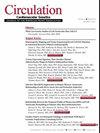1型强直性肌营养不良的重复序列和生存率。
引用次数: 1
摘要
本文章由计算机程序翻译,如有差异,请以英文原文为准。
Repeats and Survival in Myotonic Dystrophy Type 1.
The myotonic dystrophies are multisystem disorders characterized by progressive skeletal muscle weakness, myotonia, cataracts, endocrine abnormalities, cognitive impairment, and cardiomyopathy. Myotonic dystrophy type 1 (DM1) is the most common of the myotonic dystrophies. The cardiac-specific phenotypes of DM1 include progressive atrioventricular conduction delay, atrial and ventricular arrhythmias, impaired left ventricular diastolic and systolic dysfunction, impaired contractile reserve, and mesocardial fibrosis. Cardiac conduction abnormalities in patients with DM1 range from asymptomatic preclinical conduction system disease to complete heart block or ventricular arrhythmias leading to sudden death. In addition, DM1 patients are at increased risk for left ventricular dysfunction, ranging from impaired global longitudinal strain and impaired contractile reserve with preserved resting ejection fraction to overt left ventricular systolic dysfunction leading to overt heart failure.
See Article by Chong-Nguyen et al
Much concerning the pathogenesis of DM1 has been elucidated. Abnormal repeat expansion of a CTG triplet repeat in the 3′ untranslated region of the DMPK gene (dystrophia myotonica protein kinase)1 leads to accumulation of mutant transcripts in the nuclei of cells that in turn lead to dysregulated splicing and altered transcription.2,3 Sequestration of RNA-binding proteins including MBNL1 by DMPK mRNA CUG repeats and compensatory upregulation and activation of CUGBP1 (CUG-binding protein) lead to altered splicing of multiple transcripts.4–6 In addition to splicing defects, reduction of the DM protein kinase itself may contribute to the cardiac conduction defect seen in patients with DM1.7,8 Aberrant differential splicing of the SCN5A mRNA, with switching of exon 6 from the adult exon 6B to fetal 6A, is likely contributory to reductions in cardiomyocyte excitability and increased atrioventricular conduction delay.9
There is extensive evidence of a relationship between age-dependent neuromuscular dysfunction and DMPK CTG repeat length in DM1. Indeed, clinical phenotypes of late-adult-onset, classical-adult-onset, childhood-onset, …
求助全文
通过发布文献求助,成功后即可免费获取论文全文。
去求助
来源期刊

Circulation: Cardiovascular Genetics
CARDIAC & CARDIOVASCULAR SYSTEMS-GENETICS & HEREDITY
自引率
0.00%
发文量
0
审稿时长
6-12 weeks
期刊介绍:
Circulation: Genomic and Precision Medicine considers all types of original research articles, including studies conducted in human subjects, laboratory animals, in vitro, and in silico. Articles may include investigations of: clinical genetics as applied to the diagnosis and management of monogenic or oligogenic cardiovascular disorders; the molecular basis of complex cardiovascular disorders, including genome-wide association studies, exome and genome sequencing-based association studies, coding variant association studies, genetic linkage studies, epigenomics, transcriptomics, proteomics, metabolomics, and metagenomics; integration of electronic health record data or patient-generated data with any of the aforementioned approaches, including phenome-wide association studies, or with environmental or lifestyle factors; pharmacogenomics; regulation of gene expression; gene therapy and therapeutic genomic editing; systems biology approaches to the diagnosis and management of cardiovascular disorders; novel methods to perform any of the aforementioned studies; and novel applications of precision medicine. Above all, we seek studies with relevance to human cardiovascular biology and disease.
 求助内容:
求助内容: 应助结果提醒方式:
应助结果提醒方式:


